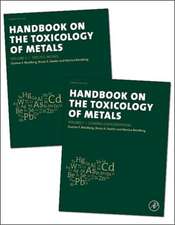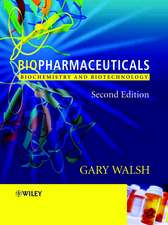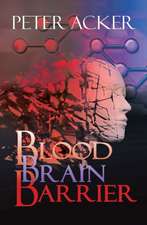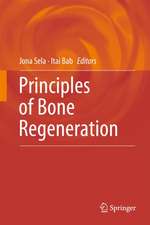Mechanistic Toxicology: The Molecular Basis of How Chemicals Disrupt Biological Targets, Second Edition
Autor Urs A. Boelsterlien Limba Engleză Paperback – 23 mar 2007
New in the Second Edition
Preț: 681.37 lei
Preț vechi: 801.61 lei
-15% Nou
Puncte Express: 1022
Preț estimativ în valută:
130.40€ • 135.63$ • 107.65£
130.40€ • 135.63$ • 107.65£
Carte tipărită la comandă
Livrare economică 14-28 aprilie
Preluare comenzi: 021 569.72.76
Specificații
ISBN-13: 9780849372728
ISBN-10: 0849372720
Pagini: 416
Ilustrații: 210 black & white illustrations, 17 black & white tables
Dimensiuni: 156 x 234 x 30 mm
Greutate: 0.77 kg
Ediția:Revizuită
Editura: CRC Press
Colecția CRC Press
ISBN-10: 0849372720
Pagini: 416
Ilustrații: 210 black & white illustrations, 17 black & white tables
Dimensiuni: 156 x 234 x 30 mm
Greutate: 0.77 kg
Ediția:Revizuită
Editura: CRC Press
Colecția CRC Press
Public țintă
Professional ReferenceCuprins
Introduction, Types of Toxic Responses, Organ-Selective Toxicity, Cellular Transport and Selective Accumulation of Potentially Toxic Xenobiotics, Bioactivation of Xenobiotics to Reactive Metabolites, Xenobiotic-Induced Oxidative Stress: Cell Injury, Signaling, and Gene Regulation, Disruption of Cellular Calcium Homeostasis, Mechanisms of Necrotic and Apoptotic Cell Death, Impairment of Cell Proliferation and Tissue Repair, Covalent Binding of Reactive Metabolites to Cellular Macromolecules, Immune Mechanisms, Cytokine-Mediated Toxicity, Specific Inactivation of Enzymes and Other Proteins, Interactions of Xenobiotics with Ion Transporters, Nuclear Receptor-Mediated Toxicity, Activation or Disruption of Cellular Signal Transduction by Xenobiotics, Disruption of Mitochondrial Function and Mitochondria-Mediated Toxicity, Novel Mechanisms Derived from Systems Toxicology, Index
Recenzii
'Students taking formal training in toxicology would definitely benefit from adding this book to their collection, since it covers many recent advances in the field.' - British Toxicology Society Newsletter
'This recently-published volume is a clear state-of-the-art explanation and description of how chemicals disrupt biological targets on a molecular basis. It is a beauty!'. - Toxicology Letters
“This book is specialized to one particular area of toxicology, the mechanisms by which topic substances work. It focuses on the general principles that link xenobiotic-induced toxicity with molecular pathways underlying those toxic effects. In includes many examples using drugs, environmental pollutants and other chemicals. … each chapter has been updated and new chapters added. … this book is intended for the advanced undergraduate of beginning graduate level student. … it might also be used by specialists in other areas needing information about the subject. … there is an extensive bibliography of papers at the end of each chapter.”
— In Books-On-Line, Web. 6207884-1433, May 2007
'This recently-published volume is a clear state-of-the-art explanation and description of how chemicals disrupt biological targets on a molecular basis. It is a beauty!'. - Toxicology Letters
“This book is specialized to one particular area of toxicology, the mechanisms by which topic substances work. It focuses on the general principles that link xenobiotic-induced toxicity with molecular pathways underlying those toxic effects. In includes many examples using drugs, environmental pollutants and other chemicals. … each chapter has been updated and new chapters added. … this book is intended for the advanced undergraduate of beginning graduate level student. … it might also be used by specialists in other areas needing information about the subject. … there is an extensive bibliography of papers at the end of each chapter.”
— In Books-On-Line, Web. 6207884-1433, May 2007
Descriere
Incorporating recent advances in molecular biology and examining cellular and molecular mechanisms with regard to toxic effects, this second edition features new chapters on types of toxic responses, novel mechanisms derived from systems toxicology, and disruption of cellular signal transduction. Expanded chapters include the disruption of mitochondrial function, mitochondrial outer membrane permeabilization, and selective depletion of mitochondrial DNA. The book links molecular and cellular biology with xenobiotic toxicology and contains new examples and illustrations to supplement material. Additional topics include oxidant stress, apoptotic and necrotic cell death, nuclear-receptor-mediated toxicity, and immune-mediated toxicity.









